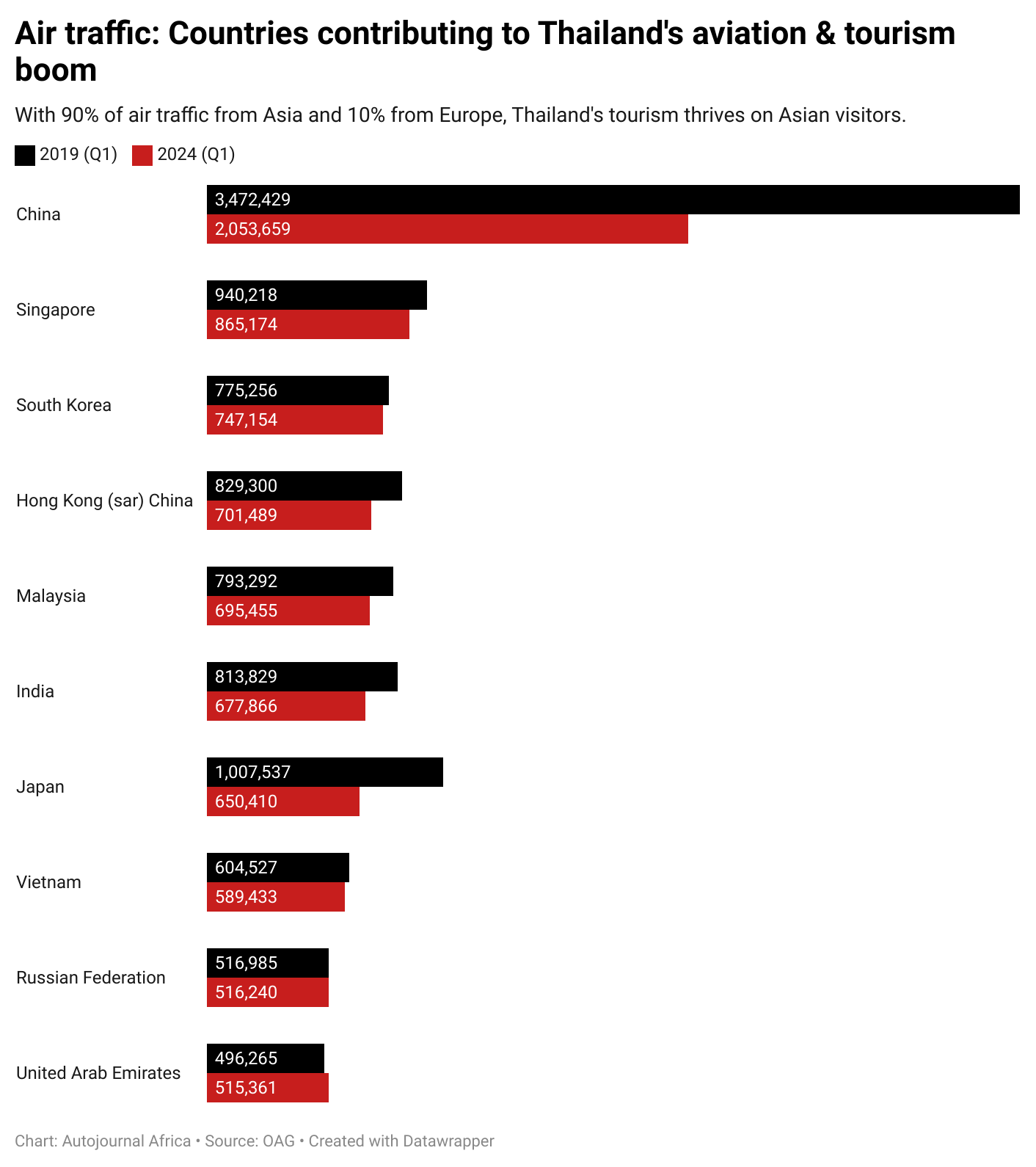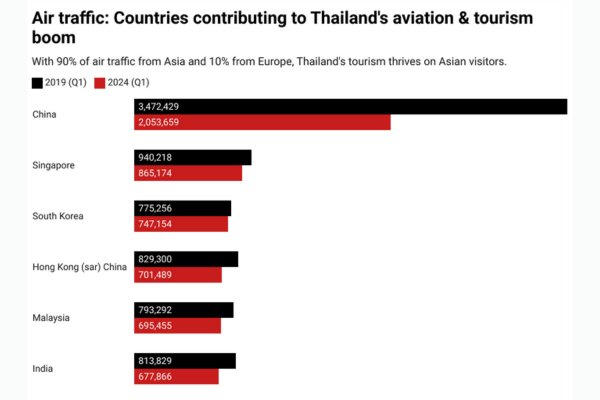Thailand has long been a magnet for tourists, drawing millions of international visitors annually to its stunning beaches, vibrant culture, and delectable cuisine. Despite the challenges posed by the pandemic, Thailand’s aviation and tourism industry is showing signs of recovery, particularly in intra-Asia travel.

China takes the lead: Visa policy boosts Chinese tourism to Thailand
China’s emergence as Thailand’s leading international market in the first quarter of 2024 can be attributed to several factors, including seasonal trends and the implementation of a new visa exemption agreement between the two countries.
The Lunar New Year, which fell on February 10, 2024, traditionally marks a peak travel period for Chinese tourists. This year was no exception, with a significant influx of Chinese visitors to Thailand during the holiday season, according to OAG. The surge in Chinese arrivals was further fueled by the implementing a permanent, reciprocal visa exemption agreement between Thailand and China, which took effect on March 1, 2024.
Under this agreement, holders of Chinese passports can enjoy visa-free stays of up to 30 days per entry in Thailand, making it easier and more attractive for Chinese tourists to visit the country. This policy change has positively impacted Chinese tourism to Thailand, contributing to China’s status as Thailand’s top international airline market in Q1 2024.
Capacity rebounds, but disparities remain

While Bangkok Suvarnabhumi Airport (BKK) has seen a partial rebound in capacity, other key airports in Thailand, such as Chiang Mai, Chiang Rai, U-Tapao, Koh Samui, and Krabi, have yet to resume connections to Chinese cities. This highlights a significant disparity between the Chinese market and other major markets, such as Singapore, South Korea, Hong Kong, and Malaysia.
Singapore ranks as Thailand’s second-largest international airline market, followed by South Korea, Hong Kong, and Malaysia. However, the performance gap between these markets and China remains substantial. For example, Singapore accounted for 865,000 seats in Q1 2024, while South Korea saw 747,000 seats during the same period.
Russian visitors are on the rise
A noteworthy trend in Thailand’s tourism sector is the increase in air capacity from Russia, particularly during the winter season. Despite facing sanctions due to its invasion of Ukraine, Russia has seen its air capacity to Thailand return to pre-pandemic levels. This surge in Russian visitors is attributed to limited flight options to alternative destinations, driving traffic to Thailand.
Looking ahead
As Thailand continues to navigate the challenges posed by the pandemic and geopolitical dynamics, the country remains optimistic about its tourism prospects. With a renewed focus on safety measures and strategic partnerships, Thailand aims to surpass its 2019 record of 40 million international arrivals, reaffirming its status as a premier tourist destination in Southeast Asia.
In conclusion, Thailand’s aviation and tourism industry is witnessing a promising recovery, driven in large part by the resilience of its intra-Asia travel market. As the country works towards welcoming more visitors in the coming months, the future looks bright for Thailand’s tourism sector.
Read more on TAP Air Portugal records $192 million profit in 2023, highest in 78 years





![Germany's auto industry [CNBC]](https://autojournal.africa/wp-content/uploads/2025/11/Germanys-auto-industry-CNBC-350x250.png)
![Foxconn [Source: TechCrunch]](https://autojournal.africa/wp-content/uploads/2025/11/Foxconn-TechCrunch-350x250.png)

![F-35 fighter jet [Source Gulf Magazine]](https://autojournal.africa/wp-content/uploads/2025/11/F-35-fighter-jet-Source-Gulf-Magazine-350x250.png)

![regional air travel in UK [Source Manufacturing Outlook]](https://autojournal.africa/wp-content/uploads/2025/11/regional-air-travel-in-UK-Source-Manufacturing-Outlook-350x250.png)
![Private jet pilot [Source Freepik]](https://autojournal.africa/wp-content/uploads/2024/04/Private-jet-pilot-Source-Freepik-75x75.png)









